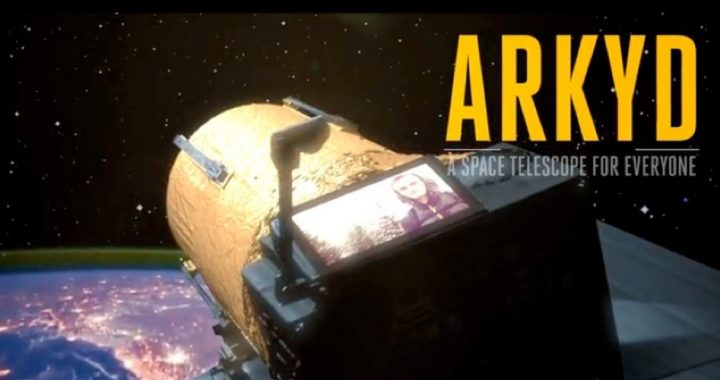
On May 29 Planetary Resources, one of two private concerns hoping to someday mine near-earth asteroids, announced plans for the first-ever crowdfunded space telescope, a venture that would allow private researchers to conduct space research using a private space telescope — and even display their photo above the Earth. As a necessary first step to locate and survey near-earth asteroids with potential for commercial use, Planetary Resources plans to build and deploy a fleet of telescope-bearing spacecraft, known as ARKYDs, for scouring the solar system. One of these will be dedicated for private use by educators, researchers, and other interested citizens, and will be able to look anywhere in space.
The ARKYDs will be significantly smaller than the Hubble Space Telescope, the most iconic and successful space observatory of them all. But they will all have much greater capability than earth-based telescopes, being hundreds of miles above the clouds, dust, artificial light, and other obstacles to deep-space viewing on the earth’s surface.
Planetary Resources’ vision is nothing less than to create civilian and student access to a domain of astronomy available up until now only to elite professional scientists and astronauts funded by public money. According to Planetary Resources, the ARKYD’s fourfold mission will be:
• To give students access to space capabilities — Whether studying planets in a 5th grade class or writing a graduate thesis, students of all ages will have the ability to direct the telescope and explore what interests them! We’re planning some exciting new educational opportunities just for K-12 educational programs.
• To support important research and discovery — There are thousands of institutions and researchers in need for greater access to in-orbit space observatories. The ARKYD will provide a new, low-cost resource to help observe distant galaxies, search for alien planets, and monitor the skies for potentially dangerous asteroids. Researchers at MIT, the University of Washington, and across the globe have shown interest in using the ARKYD to further their important research.
• To build excitement about space and all of its potential — The ARKYD is designed to be a fun and interactive experience that is accessible to anyone. This kind of direct access to a satellite is unprecedented. Our backers will be the first people in history to control a public space telescope!
• To give YOU a say — What makes this mission unique is that we’re putting control of the telescope in YOUR hands. You’ll get the opportunity to help decide which science centers and museums are the beneficiaries of ARKYD telescope time, what photos to take, and more. We’re putting YOU in control! By pledging toward this mission, you’ll receive access to our website and mobile apps allowing you to follow along with the progress of the satellite, sneak peaks at photos and videos, and get voting access to make your voice heard in the future direction of the satellite!
Planetary Resources has prepared a multi-tiered program of pledges, which will allow the public use of the ARKYD for everything from “selfies” (digital photos of donors displayed on a screen in space and photographed by the ARKYD’s camera) to advanced exploration of the solar system, stars, and distant galaxies. For 39 dollars, you can receive two prints of a “selfie,” for example, while for a $5,000 pledge, your institution can have access to a range of ARKYD’s services, including 25 Main Optic observations. A donation of $10,000 or more will get your name printed on the ARKYD and will also get a newly-discovered asteroid named in your honor.
At the time of this writing, the ARKYD crowdfunding campaign has already raised more than $234,000 of its $1 million goal — after only one day of online fundraising.
The ARKYD program is an early indicator of the promise of privatized space exploration for science. Publicly subsidized science in general, and space exploration in particular, has always been justified on the basis of the free market’s alleged inability to provide truly visionary services like cutting-edge research with no immediate commercial value. As a result, space exploration on the public dime has been characterized by chronic cost overruns, scarce resources (ask any astrophysicist how difficult it is to get “telescope time” on publicly funded telescopes), and a generational failure to live up to the promises of the “space age” as envisioned by science fiction and scientists alike (Where are the moon and Mars bases of Heinlein and Bradbury, or the manned exploration of the outer solar system promised in Space Odyssey: 2001 and other classic sci-fi epics?).
The decision to send astronauts to the moon was a political decision driven by the politics of the day (the space race with the Soviet Union). Once that race was won, there was no further political incentive to explore further, except with relatively cheap unmanned probes accessible only to scientific elites. Manned space exploration from the mid-1970s to the present day has been confined to low-earth orbit; this, too, was the result of political, not market, decisions on cost-returns.
None of this is to disparage the very real progress produced by publicly funded space programs like the Voyager probes, the Cassini Saturn probe, the various Mars landers and orbital probes, the Hubble Space Telescope and other space observatories, the Space Shuttle, and the International Space Station. But we are justified in asking — if the galloping pace of space privatization is any indication — how much further along we might be had the vision of private space commercial development been allowed to germinate sooner. The ARKYD program is just the latest piece of evidence that even cutting edge, non-commercial research, as well as education generally, stands to benefit enormously as a byproduct of a second, private-sector Space Age.
Graphic: srceen-grab from Planetary Resources video



